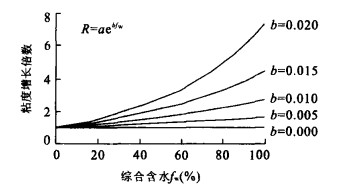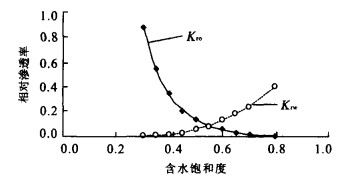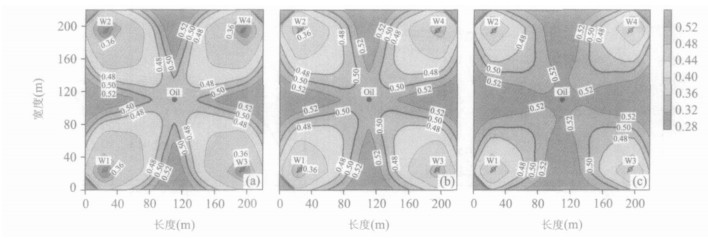Mathematical Simulation of the Effect of the Change in Oil Viscosity on Water Drive Performance
-
摘要: 为了研究注水开发油田原油粘度升高对开发效果的影响, 通过对实际油藏原油粘度统计, 回归出了原油粘度增长模型.在三维三相黑油渗流模型的基础上, 建立了一个原油粘度随含水和压力变化的油藏渗流数学模型, 并采用有限差分方法建立了相应的数值模型, 采用超松弛法对该模型进行了求解, 用Fortran90语言开发了一个新的数值模拟器.应用该模拟器模拟了不同的原油粘度变化规律对水驱效果的影响, 并与常规模拟器的结果进行了对比.结果表明: 初始水油粘度比为1∶10、含水达到98%时, 粘度增长指数由0增加到0.02, 对应的原油采出程度由44.80%降低到34.29%.目前商业软件中忽略了原油粘度随含水升高而增加的因素, 使得预测的采收率明显偏高.Abstract: The increase of crude oil viscosity can affect the production performance of oil fields when they are flooded by injection water. To study this effect, oil viscosity was analyzed statistically and its increase model was regressed. Based on the three-dimensional and three-phase black-oil model, a new mathematical model considering the change of oil viscosity caused by other factors besides formation pressure was developed. The model was discretized by the finite-difference method and solved by the LSOR (line successive over relaxation) method. A new numerical simulator written in Fortran 90 codes was developed. An oil field example of changes in oil viscosity is studied using the numerical simulator, and the changes in oil viscosity and their effects on water drive performance were studied and compared with the results given by a normal simulator. The result shows that oil recovery (water-cut arrives to 98%) decreases from 44. 80% to 34. 29% when the viscosity factor increases from 0 to 0. 02 if the initial viscosity ratio of water to oil is 1 : 10. The recovery predicted by current commercial oil reservoir simulators that neglect the increase in oil viscosity with water-cut rising is higher than true recovery.
-
Key words:
- viscosity change /
- flow in porous media /
- numerical simulation /
- recovery /
- water-cut
-
表 1 主要参数
Table 1. Main parameters

表 2 粘度增长指数对含水率和采出程度的影响
Table 2. Effects of viscosity increase exponent on water-cut and oil recovery

-
Chen, Y.S., 1993. The countermeasures against the oil reservoir heterogeneity. Petroleum Industry Press, Beijing, 133-134 (in Chinese). Deng, Y.Z., Xu, S.Y., 2003. Dynamic model of filterate parameters in delta reservoir. Acta Petrolei Sinica, 24(2): 61-64 (in Chinese with English abstract). Gai, Y.J., Lü, D.L., Gu, Y.L., et al., 2000. Numerical simulation by stages about the reservoir at high water cut period. Oil & Gas Recovery Technology, 7 (1): 54-56 (in Chinese with English abstract). Guo, Y.L., Su, G.Y., 1998. An analysis of factors affecting the precision of log interpretation of water cut in a watered out reservoir. Petroleum Exploration and Development, 25 (4): 59-60 (in Chinese with English abstract). Han, D.K., Chen, Q.L., Yan, C.Z., 1993. Oil reservoir simulation. Petroleum Industry Press, Beijing, 35-36 (in Chinese). Jiang, H.Q., Gu, J. W., Chen, Y. M., et al., 1999. The fine numerical simulation of the distribution of residual oil. Journal of the University of Petroleum, China, 23 (5): 31-34 (in Chinese with English abstract). Ju, B.S., Wang, C.T., Li, S.T., et al., 2003. Dynamic displacement characteristics of water driving oil under the variation of crude oil viscosity. Journal of Xi'an PetroleumInstitute, 18(1): 17 -20 (in Chinese with English abstract). Klara, S. M., Hemanth-Kumar, K., 1987. Comparisons of computational efficiencies of different equations of state and transport property correlations in a compositional simulator. SPE paper 16942, Proceedings of the 62nd Annual Technical Conference and Exhibition of the Society of Petroleum Engineers held in Dallas, TX September 27-30: 9-13. Liu, H.Q., 2001. The special topics for methods of oil reservoir simulation. University of Petroleum Press, Dongying, 79-84 (in Chinese). The Compilation Committee of the Scientific Series for Dagang oilfield, 1999. The practice of the development of Dagang Oilfield. Petroleum Industry Press, Beijing, 288-289 (in Chinese). Zhao, Y. H., Zhao, X.J., Weng, D. L., et al., 1999. The changes of oil reservoir formation rock properties in high water cut production stage on Xia'ermen oilfield. Acta Petrolei Sinica, 20 (1): 44-45 (in Chinese with English abstract). 陈永生, 1993. 油田非均质对策论. 北京: 石油工业出版社, 133-134. 大港油田科技丛书编委会, 1999. 大港油田开发实践. 北京: 石油工业出版社, 288-289. 邓玉珍, 徐守余, 2003. 三角洲储层渗流参数动态模型研究. 石油学报, 24(2): 61-64. doi: 10.3321/j.issn:0253-2697.2003.02.013 盖英杰, 吕德灵, 郭元灵, 等, 2000. 高含水期油藏分段数值模拟. 油气采收率技术, 7 (1): 54-56. 郭元岭, 苏国英, 1998. 水淹油层含水率解释精度影响因素分析. 石油勘探与开发, 25 (4): 59-60. doi: 10.3321/j.issn:1000-0747.1998.04.018 韩大匡, 陈钦雷, 闫存章, 1993. 油藏数值模拟. 北京: 石油工业出版社, 35-36. https://xuewen.cnki.net/CCND-SHYO202111110024.html 姜汉桥, 谷建伟, 陈月明, 等, 1999. 剩余油分布规律的精细数值模拟. 石油大学学报, 23 (5): 31-34. doi: 10.3321/j.issn:1000-5870.1999.05.009 鞠斌山, 王春田, 李师涛, 等, 2003. 变原油粘度油水两相流驱替特征研究. 西安石油学院学报, 18 (1): 17-20. doi: 10.3969/j.issn.1673-064X.2003.01.006 刘慧卿, 2001. 油藏数值模拟方法专题. 东营: 石油大学出版社, 79-84. 赵跃华, 赵新军, 翁大丽, 等, 1999. 注水开发后期下二门油田储层特征. 石油学报, 20(1): 44-45. https://www.cnki.com.cn/Article/CJFDTOTAL-SYXB901.008.htm -










 下载:
下载:





